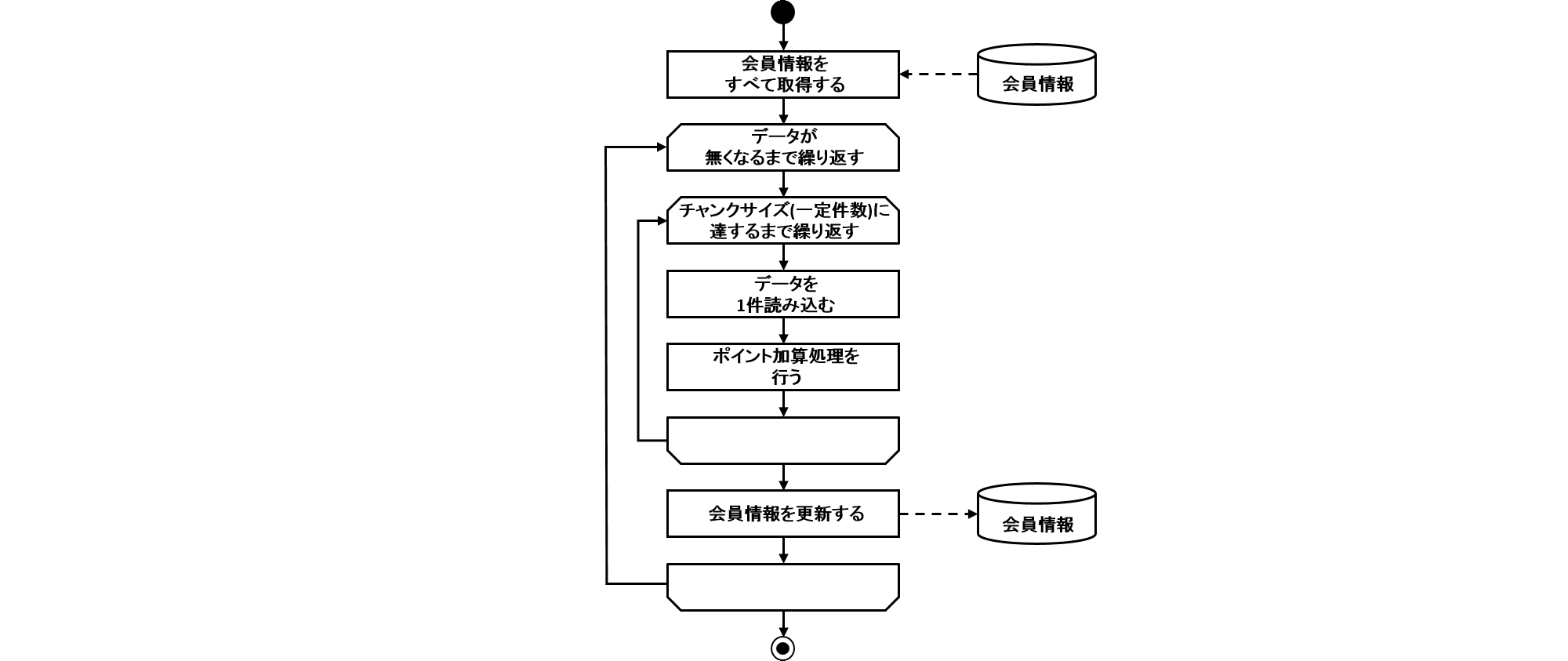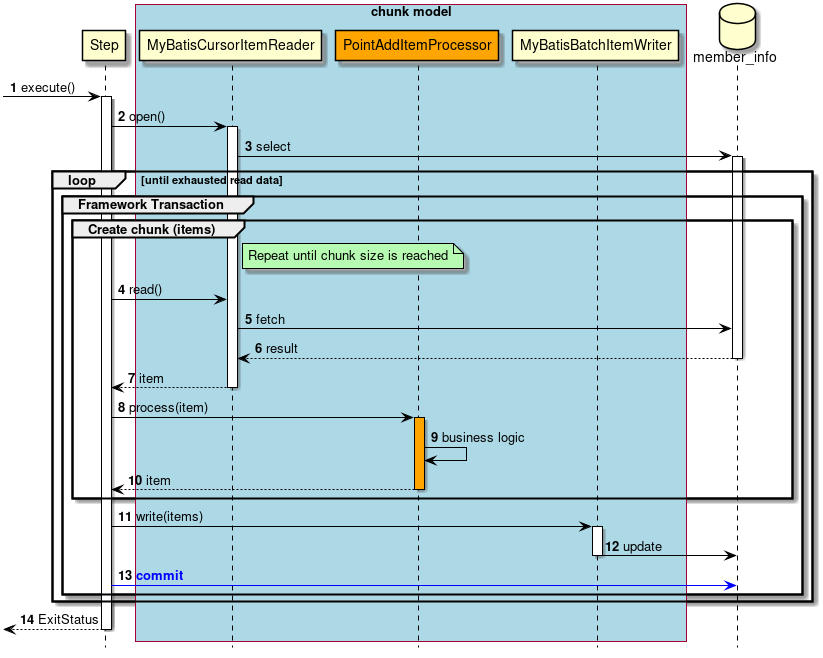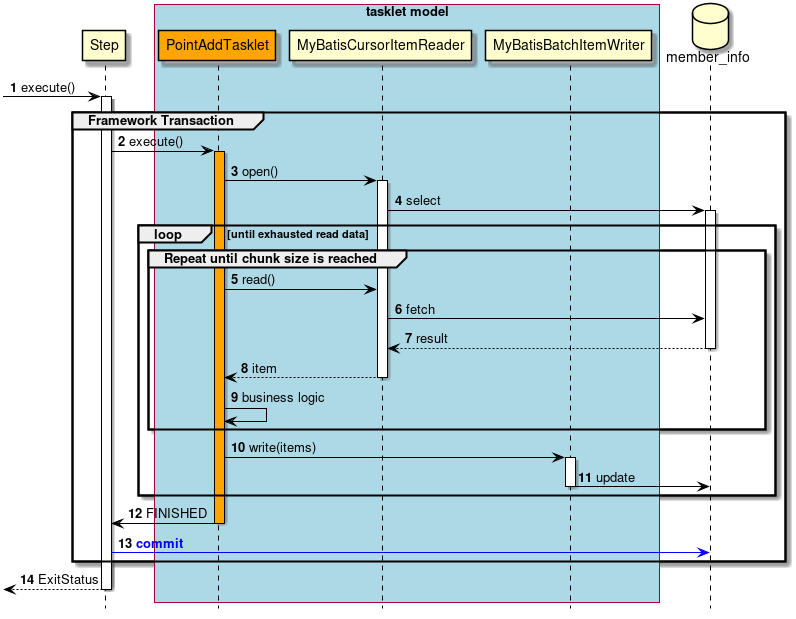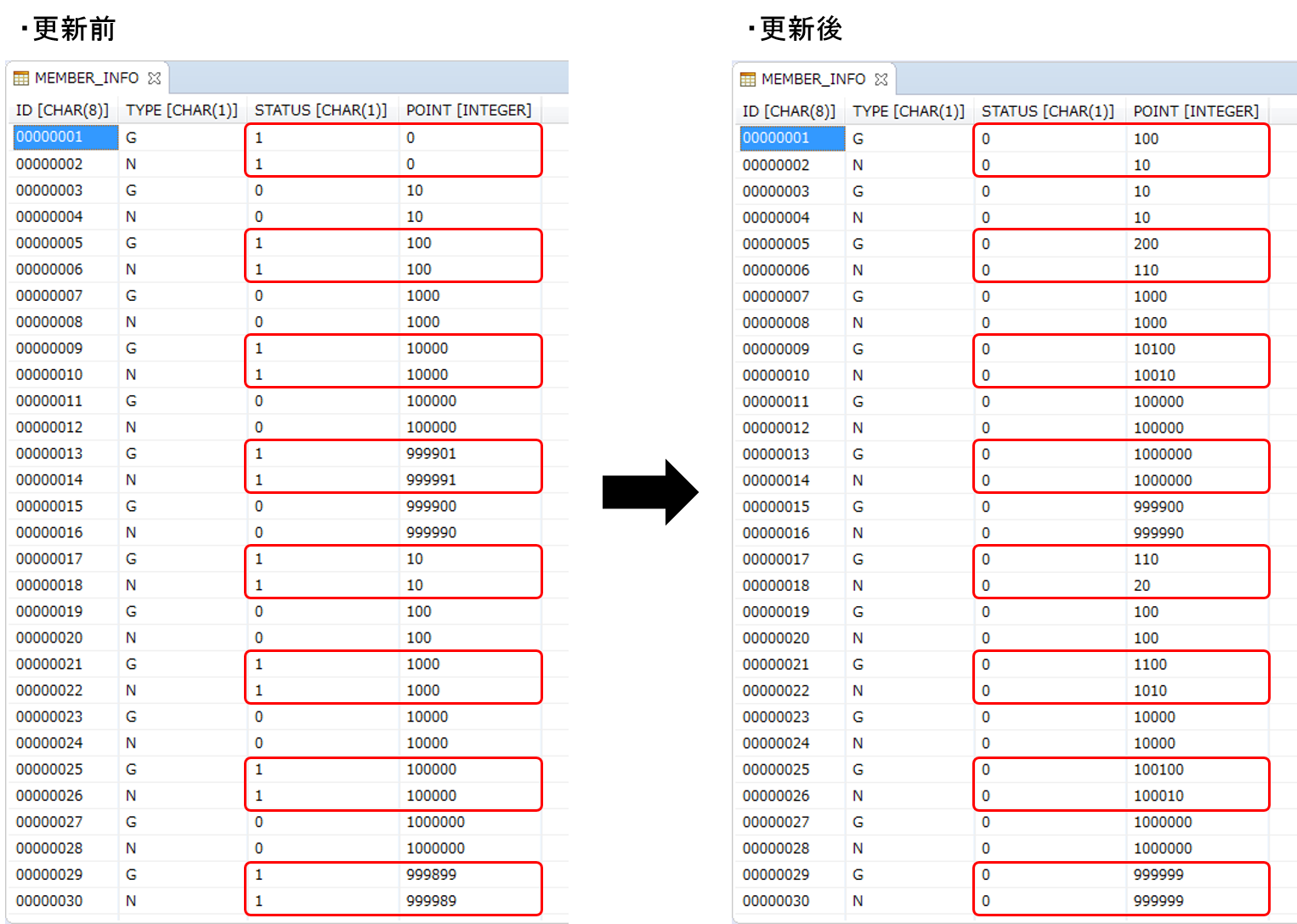Overview
Create a job which accesses a database.
Note that, since this chapter is explained based on TERASOLUNA Batch 5.x Development guideline, refer database access for details.
Background, process overview and business specifications of Explanation of application to be created are listed below.
Background
Some mass retail stores issue point cards to the members.
Membership types include "Gold members", "Normal members" and the services are provided based on membership type.
As a part of the service, 100 points are added for "gold members" and 10 points are added for "normal members" at the end of the month,
for the members who have purchased a product during that month.
Process overview
TERASOLUNA Batch 5.x will be using an application as a monthly batch process which adds points based on membership type.
Business specifications
Business specifications are as shown below.
-
When the product purchasing flag is "1"(process target), points are added based on membership type
-
Add 100 points when membership type is "G"(gold member), and add 10 points when membership type is "N" (Normal member)
-
-
* Product purchasing flag is updated to "0" (initial status) after adding points
-
Upper limit of points is 1,000,000 points
-
If the points exceed 1,000,000 points after adding points, they are adjusted to 1,000,000 points
Table specifications
Specifications of member information table acting as an input and output resource are as shown below.
| No | Attribute name | Column name | PK | Data type | Number of digits | Explanation |
|---|---|---|---|---|---|---|
1 |
Member ID |
id |
CHAR |
8 |
Indicates a fixed 8 digit number which uniquely identifies a member. |
|
2 |
Membership type |
type |
- |
CHAR |
1 |
Membership type is as shown below. |
3 |
Product purchasing flag |
status |
- |
CHAR |
1 |
Indicates whether you have purchased a product in the month. |
4 |
Point |
point |
- |
INT |
7 |
Indicates points retained by the member. |
|
Regarding table specifications
Note that table design is not done in accordance with the actual implementation considering the convenience of implementing this tutorial. |
Job overview
Process flow and process sequence are shown below in order to understand the overview of job which accesses database created here.
Process sequence covers the scope of transaction control. Transaction control for a job uses a system containing Spring Batch which is explained by defining it as a framework transaction. For details of transaction control, refer Transaction control.
- Process flow overview
-
Overview of process flow is shown below.

- Process sequence in case of a chunk model
-
Process sequence in case of a chunk model is explained.
Orange object indicates a class to be implemented now.

-
Step is executed from the job.
-
Step opens a resource.
-
MyBatisCursorItemReaderfetches all the member information from member_info table (issue select statement).-
Repeat subsequent processes until input data is exhausted.
-
Start a framework transaction in chunk units.
-
Repeat the process from 4 to 10 until a chunk size is reached.
-
-
Step fetches 1 record of input data from
MyBatisCursorItemReader. -
MyBatisCursorItemReaderfetches 1 record of input data from member_info table. -
member_info table returns input data to
MyBatisCursorItemReader. -
MyBatisCursorItemReaderreturns input data to step. -
Step performs a process for input data by
PointAddItemProcessor. -
PointAddItemProcessorreads input data and adds points. -
PointAddItemProcessorreturns process results to the step. -
Step outputs chunk size data by
MyBatisBatchItemWriter. -
MyBatisBatchItemWriterupdates member information (issue update statement) for member_info table. -
Step commits framework transaction.
-
Step returns exit code (Here, normal termination:0) to the job.
- Process sequence in case of a tasklet model
-
Process sequence in case of a tasklet model is explained.
In this tutorial, a method which is used in chunk model is adopted for tasklet model as well wherein data for a certain number of fixed records are processed together in a batch. This method enables efficient processing of a large amount of data. For details, refer Tasklet implementation which use components of chunk model.
Orange coloured object indicates a class to be implemented now.

-
Step is executed from job.
-
Step starts a framework transaction.
-
-
Step executes
PointAddTasklet. -
PointAddTaskletopens a resource. -
MyBatisCursorItemReaderfetches all the member information from member_info table (issue select statement).-
Repeat processes from 5 to 9 until input data is exhausted.
-
Repeat processes from 5 to 11 until a certain number of records is reached.
-
-
PointAddTaskletfetches 1 record of input data fromMyBatisCursorItemReader. -
MyBatisCursorItemReaderfetches 1 record of input data from member_info table. -
member_info table returns input data to
MyBatisCursorItemReader. -
MyBatisCursorItemReaderreturns input data to tasklet. -
PointAddTaskletreads input data and adds points. -
PointAddTaskletoutputs data of certain records byMyBatisBatchItemWriter. -
MyBatisBatchItemWriterupdates member information (issue update statement) from member_info table. -
PointAddTaskletreturns process termination to step. -
Step commits a framework transaction.
-
Step returns an exit code (here, successful termination: 0) to the job.
How to implement in chunk model and tasklet model is subsequently explained.
Implementation in chunk model
Processes from creation to execution for the job which accesses database in chunk model are shown with the following procedures.
Creating job Bean definition file
How to combine the elements which configure the job which accesses database in the chunk model is set in Bean definition file.
Frame and common settings of Bean definition file alone are described here and each configuration element is set in subsequent sections.
<?xml version="1.0" encoding="UTF-8"?>
<beans xmlns="http://www.springframework.org/schema/beans"
xmlns:xsi="http://www.w3.org/2001/XMLSchema-instance"
xmlns:context="http://www.springframework.org/schema/context"
xmlns:batch="http://www.springframework.org/schema/batch"
xmlns:p="http://www.springframework.org/schema/p"
xmlns:mybatis="http://mybatis.org/schema/mybatis-spring"
xsi:schemaLocation="http://www.springframework.org/schema/beans http://www.springframework.org/schema/beans/spring-beans.xsd
http://www.springframework.org/schema/context http://www.springframework.org/schema/context/spring-context.xsd
http://www.springframework.org/schema/batch http://www.springframework.org/schema/batch/spring-batch.xsd
http://mybatis.org/schema/mybatis-spring http://mybatis.org/schema/mybatis-spring.xsd">
<!-- (1) -->
<import resource="classpath:META-INF/spring/job-base-context.xml"/>
<!-- (2) -->
<context:annotation-config/>
<!-- (3) -->
<context:component-scan base-package="org.terasoluna.batch.tutorial.dbaccess.chunk"/>
</beans>| Sr. No. | Explanation |
|---|---|
(1) |
Always import settings to read required Bean definitions while using TERASOLUNA Batch 5.x. |
(2) |
Enable Bean definition by using an annotation. Use it with (3) while implementing ItemProcessor and Listener. |
(3) |
Configure component scanning. |
Implementation of DTO
Implement a DTO class as a class to retain business data.
Create a DTO class for each table.
Since it is used as common in chunk model / tasklet model, it can be skipped if created already.
package org.terasoluna.batch.tutorial.common.dto;
public class MemberInfoDto {
private String id; // (1)
private String type; // (2)
private String status; // (3)
private int point; // (4)
public String getId() {
return id;
}
public void setId(String id) {
this.id = id;
}
public String getType() {
return type;
}
public void setType(String type) {
this.type = type;
}
public String getStatus() {
return status;
}
public void setStatus(String status) {
this.status = status;
}
public int getPoint() {
return point;
}
public void setPoint(int point) {
this.point = point;
}
}| Sr. No. | Explanation |
|---|---|
(1) |
Define |
(2) |
Define |
(3) |
Define |
(4) |
Define |
Defining database access by using MyBatis
Implementation and setting for database access using MyBatis.
Implement following processes.
Since it is used as common in chunk model / tasklet model, it can be skipped if created already.
Implementation of Repository interface
Implement an interface to call SQL which is defined in MapperXML.
Since the implementation class for the interface is automatically generated by MyBatis, the developers are required to create only the interface.
package org.terasoluna.batch.tutorial.common.repository;
import org.terasoluna.batch.tutorial.common.dto.MemberInfoDto;
import java.util.List;
public interface MemberInfoRepository {
List<MemberInfoDto> findAll(); // (1)
int updatePointAndStatus(MemberInfoDto memberInfo); // (2)
}| Sr. No. | Explanation |
|---|---|
(1) |
Define a method corresponding to ID of SQL defined in MapperXML file. |
(2) |
Here, define a method to update point and status column of member_info table. |
Creating MapperXML file
Create a MapperXML file which describes settings of SQL and O/R mapping.
MapperXML file is created for each Repository interface.
It is possible to read MapperXML file automatically by storing it in a directory which is in conformance with rules defined by MyBatis. Store Mapper file in the directory at the level same as package level of Repository interface to enable reading MapperXML file automatically.
<?xml version="1.0" encoding="UTF-8"?>
<!DOCTYPE mapper PUBLIC "-//mybatis.org//DTD Mapper 3.0//EN"
"http://mybatis.org/dtd/mybatis-3-mapper.dtd">
<!-- (1) -->
<mapper namespace="org.terasoluna.batch.tutorial.common.repository.MemberInfoRepository">
<!-- (2) -->
<select id="findAll" resultType="org.terasoluna.batch.tutorial.common.dto.MemberInfoDto">
SELECT
id,
type,
status,
point
FROM
member_info
ORDER BY
id ASC
</select>
<!-- (3) -->
<update id="updatePointAndStatus" parameterType="org.terasoluna.batch.tutorial.common.dto.MemberInfoDto">
UPDATE
member_info
SET
status = #{status},
point = #{point}
WHERE
id = #{id}
</update>
</mapper>| Sr. No. | Explanation |
|---|---|
(1) |
Specify a fully qualified class name (FQCN) of Repository interface, in namespace attribute of mapper element. |
(2) |
Set SQL of reference system. |
(3) |
Set a SQL for update. |
Configuring Job Bean definition file
Add following (1) to (3) to job Bean definition file as a setting to access the database by using MyBatis.
<?xml version="1.0" encoding="UTF-8"?>
<beans xmlns="http://www.springframework.org/schema/beans"
xmlns:xsi="http://www.w3.org/2001/XMLSchema-instance"
xmlns:context="http://www.springframework.org/schema/context"
xmlns:batch="http://www.springframework.org/schema/batch"
xmlns:p="http://www.springframework.org/schema/p"
xmlns:mybatis="http://mybatis.org/schema/mybatis-spring"
xsi:schemaLocation="http://www.springframework.org/schema/beans http://www.springframework.org/schema/beans/spring-beans.xsd
http://www.springframework.org/schema/context http://www.springframework.org/schema/context/spring-context.xsd
http://www.springframework.org/schema/batch http://www.springframework.org/schema/batch/spring-batch.xsd
http://mybatis.org/schema/mybatis-spring http://mybatis.org/schema/mybatis-spring.xsd">
<import resource="classpath:META-INF/spring/job-base-context.xml"/>
<context:annotation-config/>
<context:component-scan base-package="org.terasoluna.batch.tutorial.dbaccess.chunk"/>
<!-- (1) -->
<mybatis:scan base-package="org.terasoluna.batch.tutorial.common.repository" factory-ref="jobSqlSessionFactory"/>
<!-- (2) -->
<bean id="reader"
class="org.mybatis.spring.batch.MyBatisCursorItemReader"
p:queryId="org.terasoluna.batch.tutorial.common.repository.MemberInfoRepository.findAll"
p:sqlSessionFactory-ref="jobSqlSessionFactory"/>
<!-- (3) -->
<bean id="writer" class="org.mybatis.spring.batch.MyBatisBatchItemWriter"
p:statementId="org.terasoluna.batch.tutorial.common.repository.MemberInfoRepository.updatePointAndStatus"
p:sqlSessionTemplate-ref="batchModeSqlSessionTemplate"/>
</beans>| Sr. No. | Explanation |
|---|---|
(1) |
Configure to scan Repository interface. |
(2) |
Configure ItemReader. |
(3) |
Configure ItemWriter. |
|
Accessing database other than ItemReader / ItemWriter
A method which uses Mapper interface is adopted as a method to access database other than ItemReader or ItemWriter. Since restrictions are set as TERASOLUNA Batch 5.x while using Mapper interface, Accessing database other than ItemReader/ItemWriter should be referred. For ItemProcessor implementation, refer Database access in ItemProcessor. |
Implementation of logic
Implement a business logic class to add points.
Implement following processes.
Implementation of PointAddItemProcessor class
Implement PointAddItemProcessor class which implements ItemProcessor interface.
package org.terasoluna.batch.tutorial.dbaccess.chunk;
import org.springframework.batch.item.ItemProcessor;
import org.springframework.stereotype.Component;
import org.terasoluna.batch.tutorial.common.dto.MemberInfoDto;
@Component // (1)
public class PointAddItemProcessor implements ItemProcessor<MemberInfoDto, MemberInfoDto> { // (2)
private static final String TARGET_STATUS = "1"; // (3)
private static final String INITIAL_STATUS = "0"; // (4)
private static final String GOLD_MEMBER = "G"; // (5)
private static final String NORMAL_MEMBER = "N"; // (6)
private static final int MAX_POINT = 1000000; // (7)
@Override
public MemberInfoDto process(MemberInfoDto item) throws Exception { // (8) (9) (10)
if (TARGET_STATUS.equals(item.getStatus())) {
if (GOLD_MEMBER.equals(item.getType())) {
item.setPoint(item.getPoint() + 100);
} else if (NORMAL_MEMBER.equals(item.getType())) {
item.setPoint(item.getPoint() + 10);
}
if (item.getPoint() > MAX_POINT) {
item.setPoint(MAX_POINT);
}
item.setStatus(INITIAL_STATUS);
}
return item;
}
}| Sr. No. | Explanation |
|---|---|
(1) |
Define a Bean by assigning |
(2) |
Implement |
(3) |
Define product purchasing flag: 1 for point addition, as a constant. |
(4) |
Define initial value of product purchasing flag:0, as a constant. |
(5) |
Define membership type: G (gold member), as a constant. |
(6) |
Define membership type: N (normal member), as a constant. |
(7) |
Define upper limit of points: 1000000, as a constant. |
(8) |
Define product purchasing flag, and business logic for adding points corresponding to membership type. |
(9) |
|
(10) |
|
Configuring job Bean definition file
Add following (1) and subsequent objects to job Bean definition file in order to configure created business logic as a job.
<?xml version="1.0" encoding="UTF-8"?>
<beans xmlns="http://www.springframework.org/schema/beans"
xmlns:xsi="http://www.w3.org/2001/XMLSchema-instance"
xmlns:context="http://www.springframework.org/schema/context"
xmlns:batch="http://www.springframework.org/schema/batch"
xmlns:p="http://www.springframework.org/schema/p"
xmlns:mybatis="http://mybatis.org/schema/mybatis-spring"
xsi:schemaLocation="http://www.springframework.org/schema/beans http://www.springframework.org/schema/beans/spring-beans.xsd
http://www.springframework.org/schema/context http://www.springframework.org/schema/context/spring-context.xsd
http://www.springframework.org/schema/batch http://www.springframework.org/schema/batch/spring-batch.xsd
http://mybatis.org/schema/mybatis-spring http://mybatis.org/schema/mybatis-spring.xsd">
<import resource="classpath:META-INF/spring/job-base-context.xml"/>
<context:annotation-config/>
<context:component-scan base-package="org.terasoluna.batch.tutorial.dbaccess.chunk"/>
<mybatis:scan base-package="org.terasoluna.batch.tutorial.common.repository" factory-ref="jobSqlSessionFactory"/>
<bean id="reader"
class="org.mybatis.spring.batch.MyBatisCursorItemReader"
p:queryId="org.terasoluna.batch.tutorial.common.repository.MemberInfoRepository.findAll"
p:sqlSessionFactory-ref="jobSqlSessionFactory"/>
<bean id="writer" class="org.mybatis.spring.batch.MyBatisBatchItemWriter"
p:statementId="org.terasoluna.batch.tutorial.common.repository.MemberInfoRepository.updatePointAndStatus"
p:sqlSessionTemplate-ref="batchModeSqlSessionTemplate"/>
<!-- (1) -->
<batch:job id="jobPointAddChunk" job-repository="jobRepository">
<batch:step id="jobPointAddChunk.step01"> <!-- (2) -->
<batch:tasklet transaction-manager="jobTransactionManager">
<batch:chunk reader="reader"
processor="pointAddItemProcessor"
writer="writer" commit-interval="10"/> <!-- (3) -->
</batch:tasklet>
</batch:step>
</batch:job>
</beans>| Sr. No. | Explanation |
|---|---|
(1) |
Configure job. |
(2) |
Configure step. |
(3) |
Configure a chunk model job. |
|
commit-interval tuning
commit-interval is a tuning point for performance during a chunk model job. It is set as 10 records in this tutorial, however, the appropriate number of records vary depending on available machine resources and job characteristics. Process throughput is likely to reach from 10 records to 100 records in case of a job which processes data by accessing multiple resources. Alternately, if the input and output resources are in 1:1 ratio and there are enough jobs to transfer data, process throughput can reach 5000 to 10000 records as well. It is advisable to temporarily place commit-interval to 100 records while implementing a job and then perform tuning for each job in accordance with the results of performance measurement. |
Job execution and results verification
Execute created job on STS and verify results.
Execute job from execution configuration
Create execution configuration as below and execute job.
For how to create execution configuration, refer Verifying project operations.
- Setting value for execution configuration
-
-
Name: Any name (Example: Run DBAccessJob for ChunkModel)
-
Main tab
-
Project:
terasoluna-batch-tutorial -
Main class:
org.springframework.batch.core.launch.support.CommandLineJobRunner
-
-
Arguments tab
-
Program arguments:
META-INF/jobs/dbaccess/jobPointAddChunk.xml jobPointAddChunk
-
-
Verifying console log
Verify that logs are output to console for following details.
[2017/09/12 13:32:32] [main] [o.s.b.c.l.s.SimpleJobLauncher] [INFO ] Job: [FlowJob: [name=jobPointAddChunk]] completed with the following parameters: [{jsr_batch_run_id=484}] and the following status: [COMPLETED]
[2017/09/12 13:32:32] [main] [o.s.c.s.ClassPathXmlApplicationContext] [INFO ] Closing org.springframework.context.support.ClassPathXmlApplicationContext@735f7ae5: startup date [Tue Sep 12 13:32:29 JST 2017]; root of context hierarchyVerifying exit code
Verify that the process has terminated successfully, using exit code.
For verification procedure, refer Job execution and results verification.
Verify that the exit code (exit value) is 0 (successful termination).

Verifying member information table
Compare contents of member information table before and after update and verify that the contents are in accordance with the verification details.
For verification procedure, refer Refer database by using Data Source Explorer.
- Verification details
-
-
status column
-
Records with "0"(initial status) should not exist
-
-
point column
-
Points are added according to membership type, for point addition
-
100 points when type column is "G"(gold member)
-
10 points when type column is "N"(normal member)
-
-
Records exceeding 1,000,000 points (upper limit value) should not exist
-
-
Details of member information table before and after update are as shown below.

Implementation in tasklet model
Processes from creation to execution of job which accesses database in tasklet model are implemented by following procedures.
Creating job Bean definition file
How to combine elements constituting the job which access database in tasklet model is set in Bean definition file.
Here, only frame and common settings of Bean definition file are described and each configuration element is set in subsequent sections.
<?xml version="1.0" encoding="UTF-8"?>
<beans xmlns="http://www.springframework.org/schema/beans"
xmlns:xsi="http://www.w3.org/2001/XMLSchema-instance"
xmlns:context="http://www.springframework.org/schema/context"
xmlns:batch="http://www.springframework.org/schema/batch"
xmlns:p="http://www.springframework.org/schema/p"
xmlns:mybatis="http://mybatis.org/schema/mybatis-spring"
xsi:schemaLocation="http://www.springframework.org/schema/beans http://www.springframework.org/schema/beans/spring-beans.xsd
http://www.springframework.org/schema/context http://www.springframework.org/schema/context/spring-context.xsd
http://www.springframework.org/schema/batch http://www.springframework.org/schema/batch/spring-batch.xsd
http://mybatis.org/schema/mybatis-spring http://mybatis.org/schema/mybatis-spring.xsd">
<!-- (1) -->
<import resource="classpath:META-INF/spring/job-base-context.xml"/>
<!-- (2) -->
<context:annotation-config/>
<!-- (3) -->
<context:component-scan base-package="org.terasoluna.batch.tutorial.dbaccess.tasklet"/>
</beans>| Sr. No. | Explanation |
|---|---|
(1) |
Always import settings to read required Bean definitions while using TERASOLUNA Batch 5.x. |
(2) |
Enable Bean definition by using an annotation. Use it together with (3) while implementing ItemProcessor and Listener. |
(3) |
Configure component scanning. |
Implementation of DTO
Create a DTO class as a class to retain business data.
Create a DTO class for each table.
Since it is used as common in chunk model / tasklet model, it can be skipped if created already.
package org.terasoluna.batch.tutorial.common.dto;
public class MemberInfoDto {
private String id; // (1)
private String type; // (2)
private String status; // (3)
private int point; // (4)
public String getId() {
return id;
}
public void setId(String id) {
this.id = id;
}
public String getType() {
return type;
}
public void setType(String type) {
this.type = type;
}
public String getStatus() {
return status;
}
public void setStatus(String status) {
this.status = status;
}
public int getPoint() {
return point;
}
public void setPoint(int point) {
this.point = point;
}
}| Sr. No. | Explanation |
|---|---|
(1) |
Define |
(2) |
Define |
(3) |
Define |
(4) |
Define |
Defining database access by using MyBatis
Implement and configure to access database by using MyBatis.
Implement following operations.
Since it is used as common in chunk model / tasklet model, it can be skipped if created already.
Implementation of Repository interface
Create an interface to call SQL which is defined in MapperXML file.
Since implementation class for the interface is automatically generated by MyBatis, the developer only needs to create an interface.
package org.terasoluna.batch.tutorial.common.repository;
import org.terasoluna.batch.tutorial.common.dto.MemberInfoDto;
import java.util.List;
public interface MemberInfoRepository {
List<MemberInfoDto> findAll(); // (1)
int updatePointAndStatus(MemberInfoDto memberInfo); // (2)
}| Sr. No. | Explanation |
|---|---|
(1) |
Define a method corresponding to ID of SQL which is defined in MapperXML file. |
(2) |
Here, define a method to update point column and status column of member_info table. |
Creating MapperXML file
Create a MapperXML file which describes settings of SQL and O/R mapping.
Create MapperXML file for each Repository interface.
MapperXML file can be read automatically by storing it in a directory which is in conformance with the rules defined by MyBatis. Store MapperXML file in the directory at the level same as package layer of Repository interface to enable reading of MapperXML file automatically.
<?xml version="1.0" encoding="UTF-8"?>
<!DOCTYPE mapper PUBLIC "-//mybatis.org//DTD Mapper 3.0//EN"
"http://mybatis.org/dtd/mybatis-3-mapper.dtd">
<!-- (1) -->
<mapper namespace="org.terasoluna.batch.tutorial.common.repository.MemberInfoRepository">
<!-- (2) -->
<select id="findAll" resultType="org.terasoluna.batch.tutorial.common.dto.MemberInfoDto">
SELECT
id,
type,
status,
point
FROM
member_info
ORDER BY
id ASC
</select>
<!-- (3) -->
<update id="updatePointAndStatus" parameterType="org.terasoluna.batch.tutorial.common.dto.MemberInfoDto">
UPDATE
member_info
SET
status = #{status},
point = #{point}
WHERE
id = #{id}
</update>
</mapper>| Sr. No. | Explanation |
|---|---|
(1) |
Specify fully qualified class name (FQCN) of Repository interface, in namespace attribute of mapper element. |
(2) |
Define reference SQL. |
(3) |
Define update SQL. |
Setting job Bean definition file
Add following (1) ~ (3) to job Bean definition file as a setting to access database by using MyBatis.
<?xml version="1.0" encoding="UTF-8"?>
<beans xmlns="http://www.springframework.org/schema/beans"
xmlns:xsi="http://www.w3.org/2001/XMLSchema-instance"
xmlns:context="http://www.springframework.org/schema/context"
xmlns:batch="http://www.springframework.org/schema/batch"
xmlns:p="http://www.springframework.org/schema/p"
xmlns:mybatis="http://mybatis.org/schema/mybatis-spring"
xsi:schemaLocation="http://www.springframework.org/schema/beans http://www.springframework.org/schema/beans/spring-beans.xsd
http://www.springframework.org/schema/context http://www.springframework.org/schema/context/spring-context.xsd
http://www.springframework.org/schema/batch http://www.springframework.org/schema/batch/spring-batch.xsd
http://mybatis.org/schema/mybatis-spring http://mybatis.org/schema/mybatis-spring.xsd">
<import resource="classpath:META-INF/spring/job-base-context.xml"/>
<context:annotation-config/>
<context:component-scan base-package="org.terasoluna.batch.tutorial.dbaccess.tasklet"/>
<!-- (1) -->
<mybatis:scan base-package="org.terasoluna.batch.tutorial.common.repository" factory-ref="jobSqlSessionFactory"/>
<!-- (2) -->
<bean id="reader"
class="org.mybatis.spring.batch.MyBatisCursorItemReader"
p:queryId="org.terasoluna.batch.tutorial.common.repository.MemberInfoRepository.findAll"
p:sqlSessionFactory-ref="jobSqlSessionFactory"/>
<!-- (3) -->
<bean id="writer" class="org.mybatis.spring.batch.MyBatisBatchItemWriter"
p:statementId="org.terasoluna.batch.tutorial.common.repository.MemberInfoRepository.updatePointAndStatus"
p:sqlSessionTemplate-ref="batchModeSqlSessionTemplate"/>
</beans>| Sr. No. | Explanation |
|---|---|
(1) |
Configure to scan Repository interface. |
(2) |
Configure ItemReader. |
(3) |
Configure ItemWriter. |
|
Tasklet implementation which use components of chunk model
In this tutorial, ItemReader . ItemWriter - components of chunk model are used in order to easily create a job which accesses database in the tasklet model. Refer Tasklet implementation which use components of chunk model and determine appropriately for whether to use various components of chunk model during Tasklet implementation. |
|
Accessing database other than ItemReader and ItemWriter
A method which use Mapper interface is adopted as a method to access database other than ItemReader and ItemWriter. Since restrictions are set as TERASOLUNA Batch 5.x while using Mapper interface, Database access other than ItemReader and ItemWriter should be referred. For Tasklet implementation, refer database access in Tasklet. |
Implementation of logic
Implement a business logic class which adds points.
Implement following operations.
Implementation of PointAddTasklet class
Implement PointAddTasklet class which implements Tasklet interface.
package org.terasoluna.batch.tutorial.dbaccess.tasklet;
import org.springframework.batch.core.StepContribution;
import org.springframework.batch.core.scope.context.ChunkContext;
import org.springframework.batch.core.step.tasklet.Tasklet;
import org.springframework.batch.item.ItemStreamReader;
import org.springframework.batch.item.ItemWriter;
import org.springframework.batch.repeat.RepeatStatus;
import org.springframework.stereotype.Component;
import org.terasoluna.batch.tutorial.common.dto.MemberInfoDto;
import javax.inject.Inject;
import java.util.ArrayList;
import java.util.List;
@Component // (1)
public class PointAddTasklet implements Tasklet {
private static final String TARGET_STATUS = "1"; // (2)
private static final String INITIAL_STATUS = "0"; // (3)
private static final String GOLD_MEMBER = "G"; // (4)
private static final String NORMAL_MEMBER = "N"; // (5)
private static final int MAX_POINT = 1000000; // (6)
private static final int CHUNK_SIZE = 10; // (7)
@Inject // (8)
ItemStreamReader<MemberInfoDto> reader; // (9)
@Inject // (8)
ItemWriter<MemberInfoDto> writer; // (10)
@Override
public RepeatStatus execute(StepContribution contribution, ChunkContext chunkContext) throws Exception { // (11)
MemberInfoDto item = null;
List<MemberInfoDto> items = new ArrayList<>(CHUNK_SIZE); // (12)
try {
reader.open(chunkContext.getStepContext().getStepExecution().getExecutionContext()); // (13)
while ((item = reader.read()) != null) { // (14)
if (TARGET_STATUS.equals(item.getStatus())) {
if (GOLD_MEMBER.equals(item.getType())) {
item.setPoint(item.getPoint() + 100);
} else if (NORMAL_MEMBER.equals(item.getType())) {
item.setPoint(item.getPoint() + 10);
}
if (item.getPoint() > MAX_POINT) {
item.setPoint(MAX_POINT);
}
item.setStatus(INITIAL_STATUS);
}
items.add(item);
if (items.size() == CHUNK_SIZE) { // (15)
writer.write(items); // (16)
items.clear();
}
}
writer.write(items); // (17)
} finally {
reader.close(); // (18)
}
return RepeatStatus.FINISHED; // (19)
}
}| Sr. No. | Explanation |
|---|---|
(1) |
Define a Bean by assigning |
(2) |
Define product purchasing flag:1 as a constant, for point addition. |
(3) |
Define initial value of product purchasing flag = 0, as a constant. |
(4) |
Define membership type:G (gold member), as a constant. |
(5) |
Define membership type:N (normal member), as a constant. |
(6) |
Define upper limit of points:1000000, as a constant. |
(7) |
Define a unit (fixed records): 10 to be processed together. |
(8) |
Assign |
(9) |
Define the type as |
(10) |
Define |
(11) |
Implement a product purchasing flag, and business logic which adds points according to membership type. |
(12) |
Define a list to store |
(13) |
Open an input resource. |
(14) |
Process all input resource records sequentially. |
(15) |
Determine whether number of |
(16) |
Output to database. |
(17) |
Output all process records and remaining records to database. |
(18) |
Close resource. |
(19) |
Return whether the processing of Tasklet is completed. |
Configuring job Bean definition file
Add following (1) and subsequent objects to job Bean definition file to set the created business logic as a job.
<?xml version="1.0" encoding="UTF-8"?>
<beans xmlns="http://www.springframework.org/schema/beans"
xmlns:xsi="http://www.w3.org/2001/XMLSchema-instance"
xmlns:context="http://www.springframework.org/schema/context"
xmlns:batch="http://www.springframework.org/schema/batch"
xmlns:p="http://www.springframework.org/schema/p"
xmlns:mybatis="http://mybatis.org/schema/mybatis-spring"
xsi:schemaLocation="http://www.springframework.org/schema/beans http://www.springframework.org/schema/beans/spring-beans.xsd
http://www.springframework.org/schema/context http://www.springframework.org/schema/context/spring-context.xsd
http://www.springframework.org/schema/batch http://www.springframework.org/schema/batch/spring-batch.xsd
http://mybatis.org/schema/mybatis-spring http://mybatis.org/schema/mybatis-spring.xsd">
<import resource="classpath:META-INF/spring/job-base-context.xml"/>
<context:annotation-config/>
<context:component-scan base-package="org.terasoluna.batch.tutorial.dbaccess.tasklet"/>
<mybatis:scan base-package="org.terasoluna.batch.tutorial.common.repository" factory-ref="jobSqlSessionFactory"/>
<bean id="reader"
class="org.mybatis.spring.batch.MyBatisCursorItemReader"
p:queryId="org.terasoluna.batch.tutorial.common.repository.MemberInfoRepository.findAll"
p:sqlSessionFactory-ref="jobSqlSessionFactory"/>
<bean id="writer" class="org.mybatis.spring.batch.MyBatisBatchItemWriter"
p:statementId="org.terasoluna.batch.tutorial.common.repository.MemberInfoRepository.updatePointAndStatus"
p:sqlSessionTemplate-ref="batchModeSqlSessionTemplate"/>
<!-- (1) -->
<batch:job id="jobPointAddTasklet" job-repository="jobRepository">
<batch:step id="jobPointAddTasklet.step01"> <!-- (2) -->
<batch:tasklet transaction-manager="jobTransactionManager"
ref="pointAddTasklet"/> <!-- (3) -->
</batch:step>
</batch:job>
</beans>| Sr. No. | Explanation |
|---|---|
(1) |
Configure job. |
(2) |
Configure step. |
(3) |
Configure tasklet. |
Verifying execution of job and results
Execute the created job on STS and verify results.
Execute job from execution configuration
Create execution configuration as below and execute job.
For how to create execution configuration, refer Verify project operations.
- Setup value of execution configuration
-
-
Name: Any name (Example: Run DBAccessJob for TaskletModel)
-
Main tab
-
Project:
terasoluna-batch-tutorial -
Main class:
org.springframework.batch.core.launch.support.CommandLineJobRunner
-
-
Arguments tab
-
Program arguments:
META-INF/jobs/dbaccess/jobPointAddTasklet.xml jobPointAddTasklet
-
-
Verifying console log
Verify that following details are output in Console.
[2017/09/12 10:09:56] [main] [o.s.b.c.l.s.SimpleJobLauncher] [INFO ] Job: [FlowJob: [name=jobPointAddTasklet]] completed with the following parameters: [{jsr_batch_run_id=472}] and the following status: [COMPLETED]
[2017/09/12 10:09:56] [main] [o.s.c.s.ClassPathXmlApplicationContext] [INFO ] Closing org.springframework.context.support.ClassPathXmlApplicationContext@735f7ae5: startup date [Tue Sep 12 10:09:54 JST 2017]; root of context hierarchyVerifying exit codes
Verify that the process has terminated successfully, by exit codes.
For verification procedure, refer Job execution and results verification.
Verify that the exit code (exit value) is 0 (Successful termination).

Verifying member information table
Compare contents of member information table before and after update, and verify that the contents are in accordance with the verification details.
For verification procedure, refer Refer database by using Data Source Explorer.
- Verification details
-
-
status column
-
Records with "0"(initial status) should not exist
-
-
point column
-
Points should be added in accordance with membership type, for point addition
-
100 points when type column is "G"(gold member)
-
10 points when type column is "N"(normal member)
-
-
Records exceeding 1,000,000 points (upper limit) should not exist
-
-
Contents of member information table before and after update are as shown below.
